Love spoons: How a spoon became the Welsh symbol for love
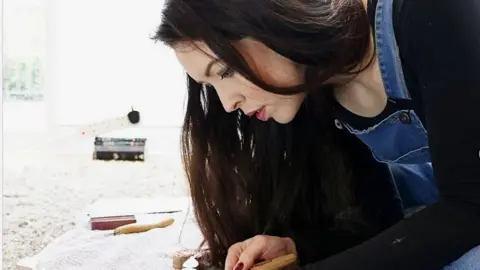 Ceini Spiller
Ceini SpillerWhen Ceini Spiller wanted to thank her mum for supporting her through university, she instinctively turned to one of the oldest traditions in Wales - carving a spoon to show love.
The love spoon - simply a piece of wood carved into the shape of a spoon, often with symbols on it - began as a way for a young man to show his sweetheart how he felt.
The first documented love spoon dates back to 1667 - and although there is a lack of written history, historians believe it significantly predates this time.
But for Ceini, at the time a trainee midwife in Swansea, it simply presented a way to show her mum how much she loved her.
Little did she know it would lead to a hobby which eventually led to her setting up as one of the few female wood spoon makers in the country, bucking centuries of tradition where women were most often the recipients, rather than the makers, of the spoons.
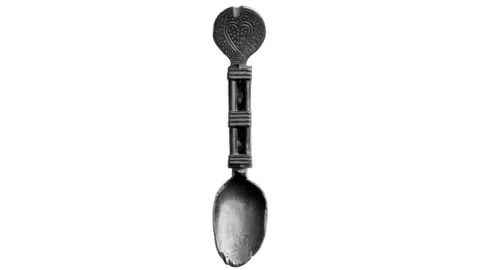 St Fagans National Museum of History
St Fagans National Museum of HistoryThe history of the love spoon was mostly passed down by the oral tradition of spoken word, according to Fflur Morse, senior curator of cultural life at the St Fagans National Museum of History in Cardiff, where they have a 300-strong collection of spoons, including that 1667 example.
"We think that the tradition started from men carving spoons for utilitarian and practical use and then the spoons becoming more decorative and handed as gifts and romantic love tokens as well," she said.
"By the 17th Century, the romantic element of it definitely took off and from that earliest love spoon we've got carvings of hearts, carvings with initials of people, so we know that that spoon was given as a romantic gift.
"The love spoons do incorporate symbols and those symbols do stand for something different.
"We can only speculate about what those symbols stand for, and obviously those symbols would have had different meanings for different people.
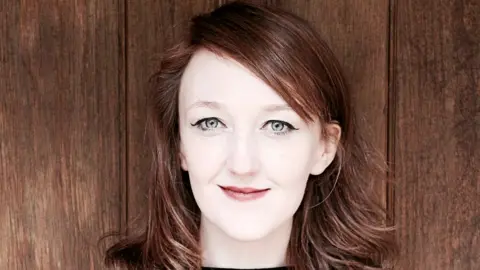 Fflur Morse
Fflur Morse"One of the most common ones is the heart, which is the universal symbol.
"A lot of our spoons do incorporate carved balls in cages and we think that was probably a symbol of how many children the carver wanted to have with the suitor.
"The earliest one has one carved circle in the spoon and we've got some with five or six."
The wheel probably showed how hard the man would work for his love, while diamonds signified wealth.
"The spoons are a real expression of the carver's feelings, desires, hopes, so they give us a real glimpse into the personal history of the couple, the carver and the receiver. They're very personal objects."
'I made it for her out of love'
The need for individuals to carve items fell with the rise of industrialisation and mass-produced items- and spoons may have fallen out of favour, as there are far fewer examples from the early 20th Century.

It became a habit reserved for craftsmen - and they were almost always men - who would make spoons for sale, albeit sometimes ordered to a particular design.
Ceini's story initially harks back to the origin story of the spoon as a personally made token of love but with a different twist to the usual romantic offering from a man to a woman.
She was aware of the tradition, and had learned about it in school but had never given or received one.
"I knew that my mother would love to receive a love spoon because she had never received one," she said.
"So as a thank-you for the three years she supported me throughout university, I decided I'd carve her a love spoon.
"I literally had no clue how to go about it so I got a pine slat from under my mattress, got a Stanley knife from the garden and just started hacking at this love spoon.
"I designed it for her and I made it for her out of love. The true essence of the tradition captured me. That's what it is, designing something for a specific person and there won't be another one like it."
 Ceini Spiller
Ceini SpillerShe spent 10 years as a midwife while refining her carving techniques as a stress reliever after work but after the births of her children, she gave up her job and opened her own love spoon and woodcraft business.
Are people surprised to find a female love spoon maker?
"I have come across quite a few surprised faces," she said.
"But within the love spoon world I know many other carvers and they are just excited and like, yes, the tradition is carrying on with a young, female artist."
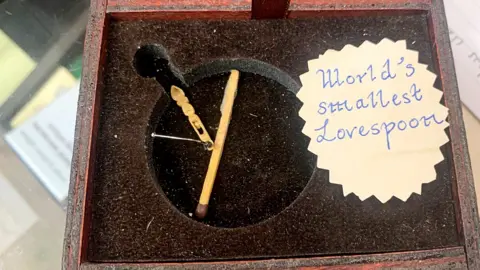
Ceini has tried to stay true to the traditions of the spoon - she only uses one knife and one gouge, or carving chisel, to make each spoon - but has also brought modern techniques into her products, for example using epoxy resin to incorporate dried flowers within the design.
She can't see any danger of love spoons dying out.
"We're Welsh, we're so proud of our traditions and I can't see how we would allow that to happen," said Ceini.
"You'd expect it just to be a gift for a wedding or an anniversary but it's literally anything from a christening to a gift for a bereaved family. People just want to show love."

'We've been waiting for the bubble to burst'
Like Ceini, the younger generations in Wales are far more aware of the love spoon tradition than used to be the case, according to Robert Rice, owner of Castle Welsh Crafts in Cardiff.
He admits to not knowing much about them when he first started selling a few back in 1978, but has seen their popularity grow and grow.
"Over the last few decades we've been kind of waiting for the bubble to burst but it didn't. Sales for love spoons have never been stronger than they are now," said Robert.
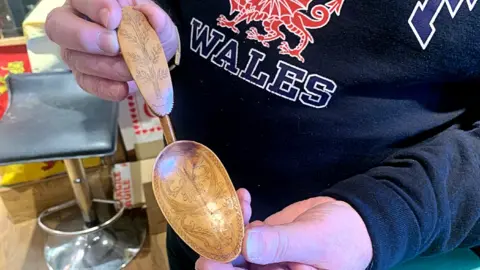
The popularity of the spoons means the shop is sometimes working the carvers that supply them "too hard", Robert jokes, but says the demand is there, and would like to put out a "call to arms" for more carvers to take up the practice.
The spoons sell to both visitors who have never heard of the tradition but want something authentically Welsh, and for expats looking to take a piece of Wales back to their new homes.
"One thing I have noticed over the 45 years that we've been in business is that there is no-one more patriotic than a Welsh person living outside of Wales," he said. "That's never varied, ever."

- FOOD FEST WALES: A culinary tour of Wales is on the menu!
- ICONIC WELSH PEOPLE, PLACES AND THINGS: Kiri Pritchard-McLean unearths the best bits from the BBC Wales archive

